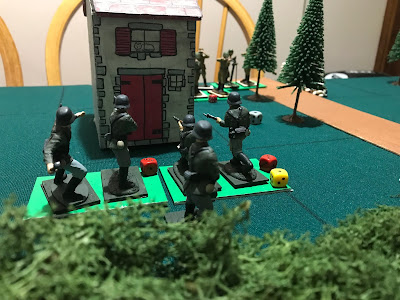The biggest change is conceptual : treating each grid-space as somewhere
around 50m^2 rather than 100m^2. This came about for two main reasons:
The first is that, even with the negative effects I added for multiple
units in a space, 100m across is roughly a platoon in attack, so
spreading squads out to cover 100m each in attack while it looked good, was out of scale (not that I'm a huge stickler for scale, clearly). 50m spaces resolve this dilemma, while still allowing more than one unit in a space (50m^2 is a lot of space).
The second reason is that this scale, or close to it, is used by more
than a few hex-and-counter tactical wargames where chits equal squads,
half squads, weapons crews and the like. In my case, I have a copy of
Lock n Load Tactical that I am referring to (since it's free) and it uses 50m. This
obviously changes the number of squares a given weapon type can cover but that's not a problem.
Rules have been added/tried/adjusted/removed/added again for platoon leaders, engineer squads, snipers, FOOs and their associated artillery strikes - including smoke, and finally, mine fields. The purpose is to allow me to play the 2 x 2 Crossfire scenarios with the same OOBs, but on a grid.
One success is that I may have made "stacking" suitably beneficial but also suitably dangerous.
One obvious problem is too many markers. Two per stand really adds up fast.
I'm trying to decide how I will handle this. I may steal from Company Command and have a single status that applies to the stand, rather than tracking hits or pins and the like separately. I have also been finding ways to reduce the number of die rolls generally - but in some cases I'm not so sure it's the best idea.
As the rules stand, actually, across iterations, the 2x2 scenarios work well. Although I haven't really just played a game to enjoy it lately as I am focused on the mechanisms and results.
The One Hour Wargame Scenarios I tried varied in their success depending on the conditions specified in the scenario- such as in one game where the Soviets had to keep two units within 12" of the hill. This made for a very lopsided game with so few numbers (the original scenario in OHW calls for 6 units per side, and this was not balanced in that way - I used the 2x2 forces. Perhaps changing the defender's unit count to match the attacker's, per OHW would yield a better result.).
Then again, even removing that condition, they still got steam rolled by the German juggernaut.
Finally, this is my 100th post on this blog. It was a bit slow getting here, but hopefully the posting pace will continue as in addition to enjoying wargaming, I like to write. I just don't do it often enough.










Really enjoying your gridded game progress and test games. Keep going l am sure you’ll continue to move forward with them. Congratulations on your hundredth post.
ReplyDeleteThank you tradgardmastare! At the way things are going, I may get another 100 posts out of my grid experiment alone!
DeleteMy 1st rule of thumb for a hobby like wargaming is "Go with the Flow" aka "Strike when the iron is hot!"
ReplyDeleteI'm pretty sure I don't have a choice in the matter - my brain uses every spare moment to think about this it seems!
Delete